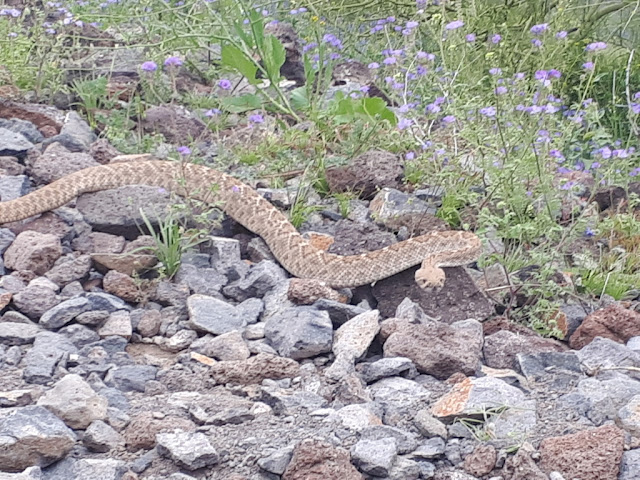Florence, about 100km southeast of Phoenix, seemed like a good place to take a break between the two planned visits and meant we didn’t have too far to drive either after our hike up Telegraph Mountain or the next day to get to our friends in Mesa, leaving time enough for a hike in the area.
With a population of about 26,000, it has no resemblance I could think of with its famous counterpart in Italy, but it was a pleasant enough location, surrounded by fields, with wide, rather quiet (at least right now) streets. It has quite a few historic buildings in its downtown core and is home to the second oldest courthouse in Arizona, now a State Park (McFarland building). Johann, who used the hour or so in the morning while I was updating my blog a bit to go for a walk, came back with the news that he had spent the entire time walking by a prison: the fence, he said, didn’t seem to end. After an hour-long wait for breakfast at the ‘Florence Café’, a restaurant I found recommended on tripadvisor (no mention of waiting times …) we stopped by the tourist information to get a recommendation for hikes. There, we found out that it was not one prison Johann had seen but a multitude: Florence, for some reason unknown to the lady at the tourist office, is home to prisons on every level, federal, state, county and private. 15,000 inmates stay in these prisons, more, she said, than the rest of the population. Later, I read that about two miles out of town was also an internment camp for German and Italian prisoners of war during WWII, while another facility, the Gila River War Relocation Centre, housed Japanese American ‘enemy aliens’ nearby. Why Florence? Maybe it is because of the fact that it borders on the desert, and escape would be difficult.
We walked up and down main street once to take a quick look at the buildings and soon were on our way out of town. Our first stop was Poston Butte, a small rise not far from the outskirts of Florence that affords a good view of the surrounding area. The short half-mile hike itself is rather uninspiring, up a pretty steep incline, but masses of lupins and other wildflowers covered the rocky flanks of the butte, and with cloudy skies, even a slight sprinkle of rain, it was not too hot. At the top is the pyramidal tomb of the man who is called the founder of Arizona, Charles D. Poston. According to Wikipedia, he lobbied President Lincoln and congress to create the state of Arizona and was appointed Superintendent of Indian Affairs because of his familiarity with the Native population in the area.
We turned back after a look around: it was windy and by no means warm up there. About half way down the trail Johann, who was walking in front of me, suddenly jumped back when a distinct rattling noise warned him to keep his distance: a rattle snake, more than a metre long, lay coiled up in the middle of the trail we had walked up only maybe fifteen minutes earlier. We watched how it slowly slithered to the side of the trail, now no longer alarmed by our presence, and continued on once it was safely on the other side. We wondered: what made Johann jump back? Had he heard the rattling first, or was it some kind of instinct we possess in these circumstances? I thought this was how I would want to have a bear encounter: to be close yet in no danger of being attacked. Of course there is no guarantee that the outcome would be like that, so it’s probably safest to hope for no close encounter, just like with rattlesnakes.
After a half-hour drive northwest through an increasingly populated area we arrived at San Tan Mountain Regional Park, a recommendation we got at the tourist info in Florence. Here, a well-developed network of hiking trails offers ample opportunity for hikes of different lengths.
By now it was about four o’clock, so we had nearly four hours of daylight, which would have been enough even for the steep climb up Goldmine trail. Neither one of us felt like engaging in too strenuous exercise today, however, and we turned off Goldmine trail to continue on a section of the longest trail of the park, San Tan, before returning to the parking lot on Moonlight trail. Plenty of wildflowers were in bloom along the 6.5 km trail, and we enjoyed the beautiful vistas of the San Tan Mountains and the many cacti. With the amount of rain this part of Arizona received this winter cacti seemed to have decided it was safe to add some growth: everywhere the tips of the saguaros had a silvery shimmer from new spines still folded over the crowns of the plants, and the jumping chollas almost seemed to glow on this cloudy day.
Again I noticed, as so often, the many birds singing here in the desert. It always amazes me that it is so more prominent than in the forested areas where we hike. This park, with very few visitors when we were there but likely well used at other times since it is so close to the Phoenix area, is a great place to hike and an alternative to the Superstition Mountains if you want to do something different.
From San Tan it was only a short drive now to Mesa where our friends were awaiting us already. It felt strange to sit inside, but it was just too cold to enjoy the evening outside on the patio. Hopefully things would change for the excursions we had planned for the next couple of days.













No comments:
Post a Comment